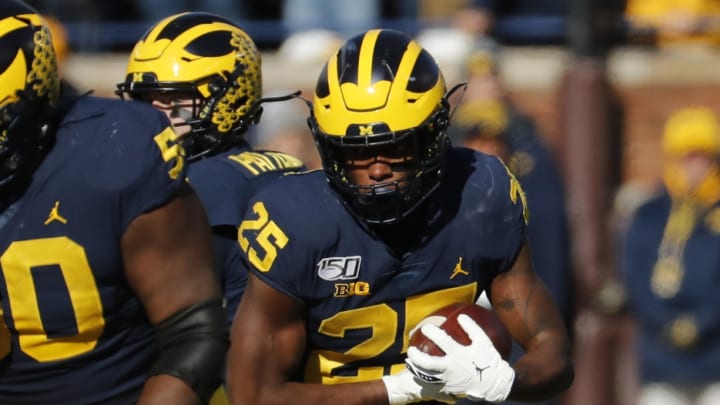Michigan Player Comparison: Hassan Haskins Is A Faster De'Veon Smith

A three-star recruit with an invitation from Purdue as his only other Power 5 offer at the time he committed to head coach Jim Harbaugh, redshirt sophomore running back Hassan Haskins was one of the more unheralded members of Michigan’s 2018 recruiting class.
After spending his freshman campaign in Ann Arbor as a reserve linebacker who saw sparse in-game action on special teams, few could have imagined \ he would be entering his sophomore season as one of the key cogs in a Wolverine running back corps that grew from a position of uncertainty in 2019 to one of the squad’s deepest units heading into 2020 spring practice.
The Missouri-native’s sophomore-season emergence seemed highly unlikely as late as five games into 2019 U-M’s slate. Buried down the depth chart following fall camp, he rushed for -3 yards on three carries in Michigan’s first three contests and had amassed only 67 total rushing yards five games in—with 45 of those coming in a 52-0 blowout victory over lowly Rutgers.
Then, in a road game in which the Maize and Blue flirted dangerously with squandering a 28-0 lead against Illinois, Haskins exploded for 125 yards and a touchdown on 12 carries (10.4 yards per carry).
Averaging 13.4 rushes per game over the Wolverines final eight tilts of the season—compared to 2.8 carries per game during the first five—he stockpiled 557 yards, four touchdowns while averaging 5.2 yards per carry.
The 6-foot-1, 220-pounder runs with a linebacker mentality and grit, initiating physicality and grinding out extra yards upon contact. Perhaps one of the more undervalued attributes a running back can posses, Haskins has the innate ability to fall forward when stopped with a consistency reminiscent of recent U-M bruiser De’Veon Smith.
Like Smith, Haskins does not have game-breaking speed, but has demonstrated the capability to use his powerful frame to churn out yardage at the end of plays and help keep Michigan’s offense ahead of the chains on early downs.
Haskins is slightly taller than Smith, who entered his final season as a Wolverine at 5-foot-11, 228 pounds, which isn’t always an advantage for a downhill running-style that requires leverage to barrel through the line of scrimmage. Haskins does have flexible hips, however, that help him lunge through the contact with a low-pad level similarly to that of Smith’s.
Haskins is faster at this stage of his career, clocking a 4.74 40 out of high school compared to Smith’s 4.8 at his pro day following his senior season. Despite this lack of top-end speed, both possess quick feet for their size which helps them hit tight windows for consistent positive yardage. To the naked-eye Haskins has better football speed and burst past the line of scrimmage.
In terms of intangibles, Smith was an excellent pass blocker for Michigan--an area in which Haskins is on the right track and was trusted by his coaches to be a bodyguard in the second half of the season. Smith was also an underrated pass-catcher out of the backfield, and finished with 38 catches for 251 yards during his career. Haskins caught six passes for 40 yards as a sophomore (6.7 yards per catch).
Looking specifically at how the two compare at this point in their careers, Haskins holds the single-season advantage with 622 yards and four touchdowns on 121 carries (5.1 yards per carry) as a redshirt freshman, an output that earned him all-conference honorable mention honors. Smith saw spotty time as a freshman, gaining 117 yards on 26 carries (4.5 yards per carry) but followed with a solid sophomore season, steamrolling for 519 yards on 108 rushes (4.8 yards per carry).
Smith progressed into a more featured role as an upperclassman, carrying the ball 180 times as a junior and 181 times as a senior, and it is yet to be seen if Haskins will be able to earn a similar share of touches while competing with sophomore Zach Charbonnet, a former top-50 recruit who gained 726 yards and 11 touchdowns on the ground in 2019.
Recently reinstated senior Chris Evans, who is responsible for 1,722 rushing yards, 392 receiving yards and 16 total touchdowns thus far in his career, will also be in the mix.
Although Michigan should still employ power-run game principles under offensive coordinator Josh Gattis, as demonstrated by his first season in Ann Arbor, Haskins will exist in an offense that, in theory, leans more toward the spread style than the offenses that Smith was featured in during his collegiate career.
Check out our player comparisons for WR Nico Collins and WR Giles Jackson.
